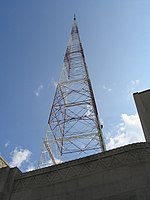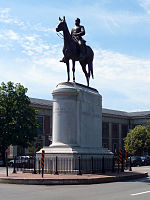Tower Building (Richmond, Virginia)
1961 establishments in VirginiaBuildings and structures in Richmond, VirginiaCommercial buildings completed in 1961Commercial buildings on the National Register of Historic Places in VirginiaInternational style architecture in Virginia ... and 1 more
National Register of Historic Places in Richmond, Virginia

The Tower Building is a historic office building located in Richmond, Virginia. It was built in 1961 by architect David Warren Hardwicke, and designed in the International Style. It features a brise soleil made of brick as well as a ground floor shaded parking lot situated underneath the building's two stories of offices. The structure likely derives its name from the WTVR TV Tower located across the street. The office building was listed on the National Register of Historic Places in 2017. It resides within, but is a non-contributing resource to, the Scott's Addition Historic District.
Excerpt from the Wikipedia article Tower Building (Richmond, Virginia) (License: CC BY-SA 3.0, Authors, Images).Tower Building (Richmond, Virginia)
Cutshaw Avenue, Richmond
Geographical coordinates (GPS) Address Phone number External links Nearby Places Show on map
Geographical coordinates (GPS)
| Latitude | Longitude |
|---|---|
| N 37.565833333333 ° | E -77.475555555556 ° |
Address
Panic Anxiety & Depression Center
Cutshaw Avenue 3212
23221 Richmond
Virginia, United States
Open on Google Maps








